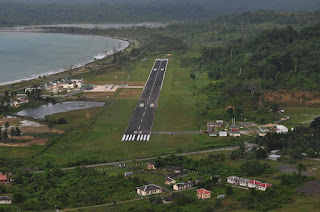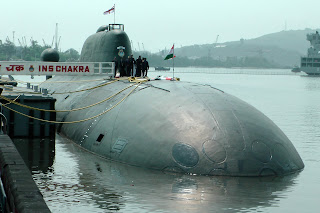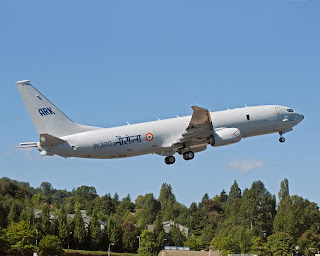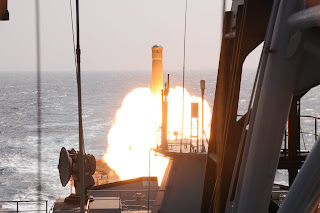arp2041
BANNED

- Joined
- Apr 4, 2012
- Messages
- 10,406
- Reaction score
- -9
- Country
- Location

Gushing out of the earth through narrow pipelines, oil is fated also to travel to its consumers through narrow bottlenecks. The Strait of Hormuz, just 34 kilometres wide, is the Persian Gulf exit through which supertankers haul away some 17 million barrels of oil daily. Five thousand kilometres later, at the doorstep of the oil guzzling economies of China, Japan and Indonesia, these giant vessels squeeze through the Malacca Strait, just 3 kilometres wide, leaving behind the Indian Ocean and entering the Pacific.
Global security managers lavish attention on the security of these two bottlenecks, but remain sanguine about the vast expanse of water that connect them: the Arabian Sea, the Bay of Bengal and the Andaman Sea at the mouth of the Malacca Strait. But this stretch is the bailiwick of the Indian Navy, the only major navy that operates between Qatar --- the forward headquarters of the United States Central Command (CENTCOM) --- and the contested and militarised waters of the South China Sea, beyond the Malacca Strait.
Besides keeping a watchful eye over the international shipping lanes that run through the northern Indian Ocean, the Indian Navy is also the gatekeeper of two more choke points near its offshore island chains of Lakshadweep and the Andamans. All Pacific-bound shipping from the Persian Gulf, or the Red Sea, converges on a 200 kilometres wide funnel called the Ten Degree Channel (named after its latitude) that is straddled by India’s Lakshadweep island chain. Given these islands’ strategic control over the shipping lanes, the Kochi-based South-Western Naval Command established a naval base on Lakshadweep in April this year.
Patrol vessels, aircraft and radars on this base, INS Dweeprakshak (INS stands for Indian Naval Ship, a confusing appellation, since the navy uses it for ships as well as shore bases), plays guardian angel to merchant shipping on the international shipping lane (ISL) that runs through the Ten Degree Channel. The navy seeks no compensation for keeping pirates at bay, or responding to emergencies. This comes with the turf for a regional power’s navy. And, in the event of a crisis, this positions the navy well for closing the channel to unfriendly shipping, or “enforcing a blockade” in military parlance.
In the Bay of Bengal, twelve hundred kilometres from the Indian mainland, sits another strategically priceless island chain called the Andaman and Nicobar Islands. These too dominate the international shipping lane that runs past them, through the 200-kilometre wide Six Degree Channel, before entering the Malacca Strait. Over the last two decades, India has transformed the Andamans (as the island chain is called) from a military backwater into the bristling Andaman & Nicobar Command (ANC). This expanding presence, with a growing complement of naval, air and ground assets, is India’s first (and only) tri-service command, headed in rotation by three-star generals, admirals and air marshals, who report directly to the Integrated Defence Staff in New Delhi.
According to a recently retired navy fleet commander who spoke on the condition of anonymity, the Lakshadweep and Andamans give India a double stranglehold over these international shipping lanes, make it the natural master of the northern Indian Ocean. Iran’s bluster about shutting down the Strait of Hormuz can evoke scepticism, but analysts agree that the Indian Navy --- with its flotilla of 134 modern warships --- can shut down the Indian Ocean shipping lanes whenever it chooses. At stake here are not just the oil supplies of China, Japan and the ASEAN states, but also the reverse flow of exports that are crucial to these economies. All told, some 60,000 vessels move through the Strait of Malacca each year, one every nine minutes.
“A couple of submarines and a fighter squadron at Car Nicobar could easily enforce a declared blockade,” says the retired fleet commander.
Last fortnight, this capability was strengthened when India’s just-retired naval chief, Admiral Nirmal Verma (he handed charge on Friday to Admiral DK Joshi), inaugurated a naval air base, INS Baaz, at the very mouth of the Malacca Strait. This base, which will eventually have a 10,000-foot-long runway for fighter operations, is 300 kilometres closer to the Malacca Strait than Car Nicobar,.
Noted geo-strategist, Robert Kaplan, notes India’s crucial geography in this area: “India stands astride the Indian Ocean… the world’s energy interstate, the link for megaships carrying hydrocarbons from the Middle East to the consumers in the burgeoning middle-class concentrations of East Asia. India, thus, with the help of the Indian Ocean, fuses the geopolitics of the Greater Middle East with the geopolitics of East Asia — creating an increasingly unified and organic geography of conflict and competition across the navigable southern rim of Eurasia.”
But New Delhi does not intend this ocean to be a hotly contested strategic prize. Instead, oil and merchandise must flow smoothly, crucial for its growing economy. But the Indian Navy’s level statements and its rapid growth also indicate that India plans to retain local superiority over its Chinese counterpart, the People’s Liberation Army (Navy), which would allow it to counter any Chinese aggression on the Himalayan frontier with a blockade of Chinese shipping in the Indian Ocean.
The growth of the PLA(N) can hardly be matched from within the resources of the smaller Indian economy. But New Delhi believes that the PLA(N) will be increasingly preoccupied with the growing regional presence of the US Navy that is presaged by the “rebalance to the Asia Pacific region” that President Barack Obama announced earlier this year. While Obama specifically named India as a key regional partner, New Delhi has chosen a more balanced role, which would not commit India to taking sides in any confrontation.
Admiral Verma declared in New Delhi in August that, notwithstanding “major policy statements from the US, from our perspective the primary areas of interest to us is from the Malacca Strait to the (Persian/Arabian) Gulf in the west, and to the Cape of Good Hope in the south… the Pacific and the South China Sea are of concern to us, but activation in those areas is not on the cards.”
India’s quiet assumption of primacy in the Indian Ocean does not go unchallenged by regional rivals. Chinese leaders, dating back to Defence Minister Chi Haotian in 1994, have protested that, “The Indian Ocean is not India’s ocean.” But the fundamental determinants of naval power --- force levels and proximity --- suggest that China is some way from being able to challenge India in its own oceanic backyard.
Senior government sources say that the navy is being careful that its new teeth and claws do not set off alarm bells anywhere. In the 1980s, India’s acquisition of a flurry of Soviet Union warships caused regional countries like Australia and Indonesia to openly question the reason for that naval build-up. This time around, there is painstaking transparency; the navy publicly bean counts all its recent and forthcoming acquisitions.
This was evident at Admiral Verma’s farewell press conference last month. He listed out the recently inducted warships that had taken the navy’s count to 134: three Project 17 stealth frigates (INS Shivalik, Satpura and Sahyadri); two fleet tankers (INS Deepak and Shakti); one Russian 1135.6 Class stealth frigate (INS Teg); the nuclear attack submarine, INS Chakra, which has been leased from Russia; a sail training ship (INS Sudarshini); and eight water-jet Fast Attack Craft.
Another 43 warships, revealed Verma, were under construction in India. These include three Project 15A destroyers (INS Kolkata, Kochi and Chennai), being built by Mazagon Dock Ltd, Mumbai (MDL), which would start induction next year; four more similar destroyers under Project 15B; six Scorpene submarines being built at MDL; four anti-submarine warfare corvettes, being built at Garden Reach Shipbuilders & Engineers, Kolkata (GRSE), which would start entering service next year; four offshore patrol vessels (OPVs) being built by Goa Shipyard Limited (GSL) would commence induction later this year; five more OPVs and two cadet training ships are being built by private shipyards. Eight landing craft are being built by GRSE for the Andamans; six new catamaran-hulled survey vessels, the first of which will join the navy this year.
Also joining the navy would be three more warships from Russia: the aircraft carrier, INS Vikramaditya (formerly the Gorshkov) would enter service this year; and two more frigates of the Teg class would join the navy’s fleet in 2013-14. All this would ensure that “over the next five years we expect to induct ships and submarines at an average rate of 5 platforms per year, provided the yards deliver as per contracted timelines,” said Verma.
All this is still insufficient to meet the navy’s Maritime Capability Perspective Plan (MCPP) target of a 160-ship force that is built around 90 capital warships, like aircraft carriers, destroyers, frigates and corvettes. Today the navy has barely half the destroyers and frigates it needs. And the 5 vessels that will be inducted each year will barely suffice to replace warships that are decommissioned after completing their 30-40 year service lives.
“Looking just at numbers conveys an over-gloomy picture,” a highly placed MoD source tells Business Standard. “Replacing a single-role frigate built in the 1960s or 1970s with a multi-role, stealth frigate that we build today is hardly a one-for-one transaction. It represents a significant accretion of capability. And so, we are looking at capabilities, not just at numbers.”
But numbers are important, especially when it comes to covering a vast maritime domain. In anti-piracy operations around the Gulf of Aden, where Indian, Chinese and Japanese warships conduct patrols in coordination with one another, India has managed to sustain a single warship on patrol. China, in contrast, sustains three, including a logistics replenishment vessel. India scrapes the bottom of its 134-ship barrel to muster warships for the range of exercises it conducts with the US, Russia, UK, France and Singapore, amongst others. The PLA(N)’s armada of more than 500 warships allows it to send vessels on lengthy deployments, such as port calls to eastern and southern African countries that front the Indian Ocean.
Realising that defence shipyards alone cannot bridge the navy’s shortfall, the MoD has encouraged shipyards like MDL and GRSE to forge joint ventures (JVs) with private shipyards that have created impressive infrastructure for building warships. These include L&T’s brand new Katupalli shipyard at Ennore, Tamil Nadu; Pipavav Defence and Offshore Engineering Co Ltd at Bhavnagar, Gujarat; and ABG Shipyard at Dahej, Gujarat. The JVs seek to marry the experience of defence shipyards with the infrastructure and entrepreneurial ability of the private sector shipyards.
Several western navies, like the UK’s Royal Navy, make up for smaller numbers by functioning in alliances, which has allowed them to concentrate on particular types of vessels (the Royal Navy focuses on anti-submarine warfare) while other partners handle other operational dimensions. With the Indian Navy determined to stay clear of alliances (“we can be a partner, but not an ally,” says a senior officer) it will be forced to find a way of putting in place the flotilla needed for policing the ocean that India increasingly considers its own.
* * * * *
AN EXPANDING FORCE
Indian Navy force multipliers
1. Sea Control

Aircraft carrier INS Vikramaditya, formerly the Gorshkov, will be delivered this year. Like India’s existing carrier, the INS Viraat, this floating airfield will allow the navy to impose control over a large expanse of sea, a long distance away from land bases.
2. Strategic Bases

Far-flung bases like Car Nicobar and Campbell Bay in the Andamans (pictured here), which function like unsinkable aircraft carriers, allow air power to be applied at locations very far away from the mainland. The Andaman & Nicobar Islands are 1200 km away from the mainland.
3. Blockade of Shipping

The nuclear attack submarine INS Chakra, along with 14 existing submarines and 6 Scorpenes that will come by 2018, can impose a blockade on shipping at choke points in the Indian Ocean. These include the Strait of Hormuz; Nine Degree Channel; Six Degree Channel; Malacca Strait.
4. Maritime Domain Awareness

Reconnaissance aircraft like the P8I (India has bought 8, the first of which will join the navy next year) will allow it to effectively monitor oceanic areas. India is also scouting around for 8 medium range maritime reconnaissance aircraft.
5. Land Attack

The Brahmos cruise missile, which is now standard fitment on all naval warships, provide a potent capability to attack targets that are 200-250 kilometres inland.
Broadsword: Indian Ocean: the new Great Game










